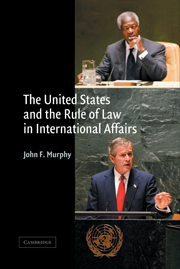Book contents
- Frontmatter
- Contents
- Acknowledgments
- Introduction
- 1 Law and legal process in international affairs
- 2 The status of international law under US law
- 3 UN dues
- 4 Use of force
- 5 Arms control, disarmament, nonproliferation, and safeguards
- 6 The law of the sea
- 7 The International Court of Justice
- 8 Prevention, prosecution, and punishment of international crimes
- 9 Human rights and international environmental issues
- 10 Summary and conclusions, and some possible future scenarios
- Index
2 - The status of international law under US law
Published online by Cambridge University Press: 22 September 2009
- Frontmatter
- Contents
- Acknowledgments
- Introduction
- 1 Law and legal process in international affairs
- 2 The status of international law under US law
- 3 UN dues
- 4 Use of force
- 5 Arms control, disarmament, nonproliferation, and safeguards
- 6 The law of the sea
- 7 The International Court of Justice
- 8 Prevention, prosecution, and punishment of international crimes
- 9 Human rights and international environmental issues
- 10 Summary and conclusions, and some possible future scenarios
- Index
Summary
The strength of a country's adherence to the rule of law in international affairs is linked in substantial measure to the extent to which international law can be enforced through national mechanisms. The enforcement of international law through national mechanisms is grounded in the relationship between international law and national law in national legal systems, and this relationship varies considerably from country to country.
From a theoretical perspective the basic distinction is between the monist and dualist (or pluralist) approaches to the relation of international law to national law. Monists consider international law and national law as parts of a single legal system. Monists also often see national law as deriving its validity from international law, which enjoys a higher status in a hierarchy of legal norms. Under the monist approach, international law overrides conflicting national law, including constitutional limitations, and individuals have international legal personality.
In sharp contrast, dualists regard international law and national law as two separate legal systems which operate on different levels. International law can be applied by national mechanisms, particularly courts, only when it has been “transformed” or “incorporated” into national law. Moreover, even when it has been incorporated into national law, international law is subject to constitutional limitations applicable to national law, and may be repealed or superseded by legislative action for purposes of national law. Dualists also stress the international legal personality of states and downgrade or deny that of individuals or other entities.
- Type
- Chapter
- Information
- Publisher: Cambridge University PressPrint publication year: 2004
- 2
- Cited by



